What was formerly believed to be a gas and dust cloud at the center of the galaxy essentially comprises three very young stars. That is the finding of a new study carried out by researchers from the University of Cologne’s Institute of Astrophysics.

Image Credit: Avigator Fortuner/Shutterstock.com
The European Southern Observatory’s Very Large Telescope (VLT) — a telescope with a mirror having 8.20 m diameter located on the peak of Cerro Paranal in Chile — provided the information for the study, which has been published in The Astrophysical Journal. The stars started to develop less than 1 million years ago, which is very young from an astrophysical standpoint. By comparison, the sun is only less than 5 billion years old.
In 2011, an object was discovered with the help of the infrared data measured by the Very Large Telescope, promising to unravel an extraordinary process at the center of the galaxy. Using a multi-wavelength analysis, researchers established that it is a cloud of gas and dust, which was labeled G2.
The interaction with the black hole at the galaxy’s center, SgrA*, should have ripped G2 apart and resulted in proverbial fireworks. The scientists anticipated that when G2 bumped into SgrA*, numerous processes would result in the gas and dust making the black hole flare-up. But that did not take place.
Furthermore, there were other aspects that gave astronomers worldwide a headache and stimulated divisive discussions. Studies revealed that the temperature of G2 is nearly two times as high as that of neighboring dust sources.
One probable explanation for G2’s temperature is the extreme number of stars at the galaxy’s center. So, these stars may have raised the heat up in G2. The only question is why all other identified dust sources at the galaxy’s center exhibit a much lower temperature.
The black hole, SgrA*, was also eliminated as a heat source. The temperature of G2 should have grown when the supposed dust cloud moved closer to the black hole — similar to how one would feel if he/she moved toward a radiator.
However, the temperature stayed constant for a long time, although the distance to the black hole differed. The more carefully G2 was tracked globally, the more it became obvious that the cosmic entity had to be more than merely a cloud of gas and dust.
The new findings reveal that G2 really comprises three individual stars.
We had the opportunity to observe the centre of our galaxy ourselves several times with the Very Large Telescope. Together with the data from the Southern Observatory archive, we were able to cover a period from 2005 to 2019.
Dr. Florian Peissker, Study Lead Author, Institute of Astrophysics, University of Cologne
The uncommon structure of the data was also useful in detecting G2. Each pixel of the captured image has a related spectrum that covers a highly specific and comprehensive waveband. For the researchers, this delivers a huge level of detail.
That G2 actually consists of three evolving young stars is sensational. Never before have stars younger than the ones found been observed around SgrA*.
Dr. Florian Peissker, Study Lead Author, Institute of Astrophysics, University of Cologne
The findings pave the way to many more intriguing research questions — for example, where these young stars appeared from. The radiation-concentrated environment of a supermassive black hole is not automatically the best place to birth young stars.
The new results provide unique insights into how black holes work. We can use the environment of SgrA* as a blueprint to learn more about the evolution and processes of other galaxies in completely different corners of our Universe.
Dr. Florian Peissker, Study Lead Author, Institute of Astrophysics, University of Cologne
Journal Reference:
Peissker, F., et al. (2021) The Apparent Tail of the Galactic Center Object G2/DSO. The Astrophysical Journal. doi.org/10.3847/1538-4357/ac23df.